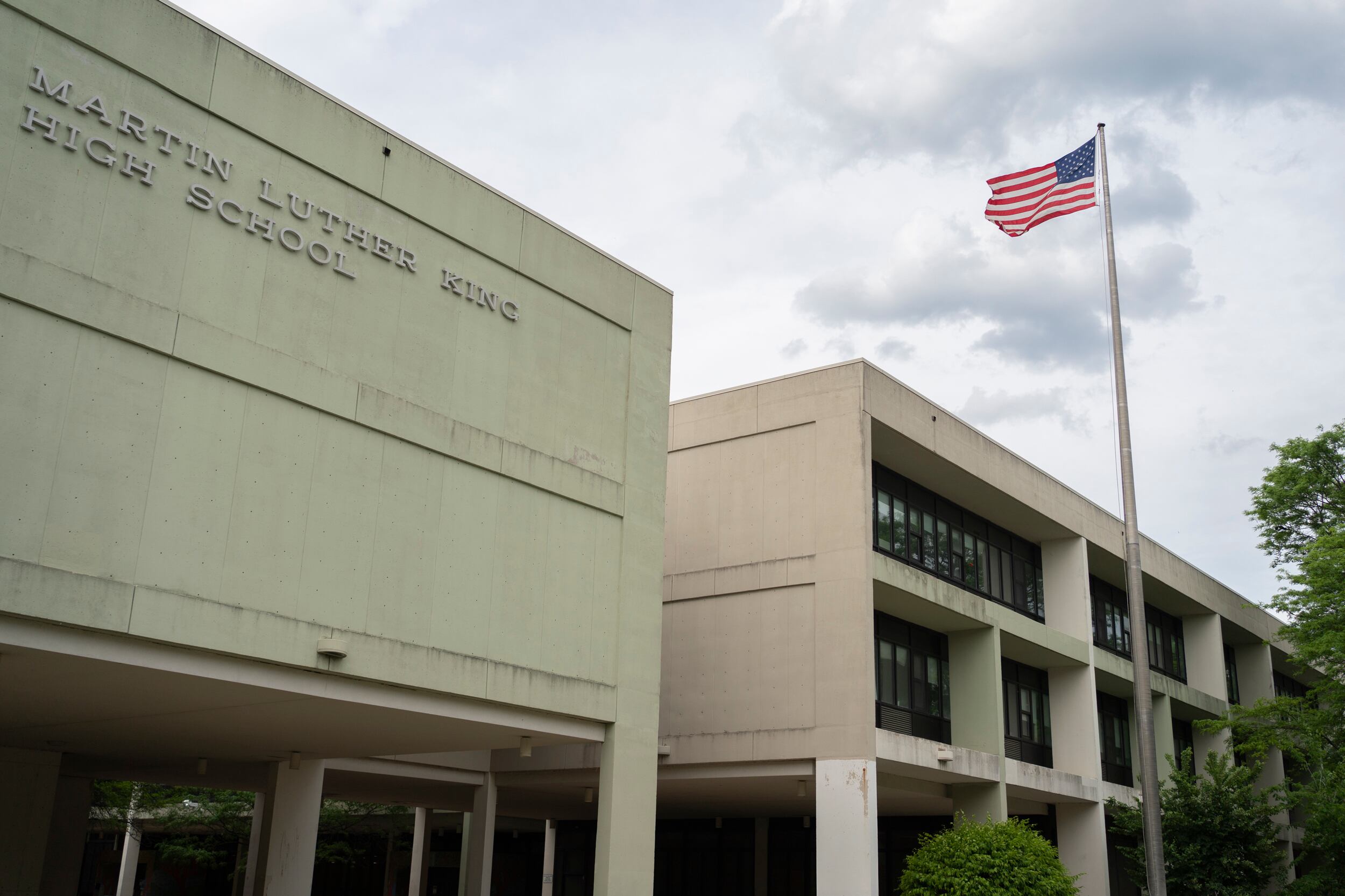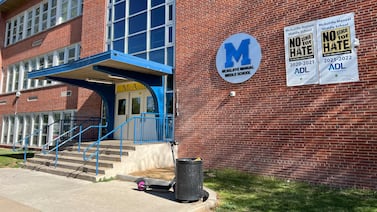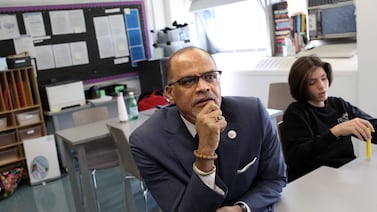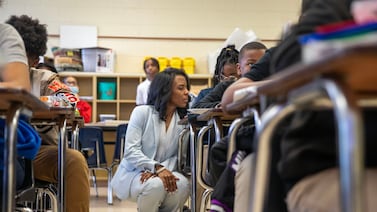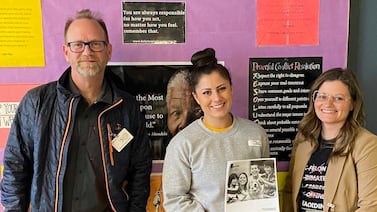Laila McKinney was dreading senior year at Chicago’s King College Prep. Not just because of COVID-19. Not just because last year was disrupted by remote learning.
But because the 18-year-old’s long-term dance teacher, someone she considers a cherished mentor, and her journalism teacher wouldn’t be there. The two were among the 562 educators — 272 teachers and 290 non-teacher employees — laid off by Chicago Public Schools at the end of last school year.
The number of layoffs this past spring was the lowest in several years. Still, a Chalkbeat analysis found the layoffs hit small schools in high-poverty areas disproportionately hard. Most schools with clusters of three or more teacher layoffs were shrinking campuses, with at least seven of the 22 schools considered “underutilized” by the district, meaning their enrollment falls significantly short of the building capacity.
At least two schools, King and Christian Fenger Academy, laid off 15% of their staff, though Fenger was among the few schools on the list that has gained enrollment over the past two years and planned to add staff this year, according to budget documents. Representatives from King and Fenger did not respond to requests for comment before publication time.
Every spring brings a cycle of layoffs in Chicago in response to factors such as budget, enrollment, and programmatic changes. The district rehires the vast majority of laid-off staff each fall, usually at different campuses. When asked to provide the number of teachers rehired this fall, the district could not provide an updated tally by publication time, and instructed Chalkbeat to file a public records request.
Chicago’s teacher layoff numbers are under particular scrutiny this fall for two reasons. Advocates and the Chicago Teachers Union say the district should have used federal pandemic relief money to prevent the layoffs. They asserted the layoffs take a toll on school programming, resources, and communities, making it difficult to recruit new students when enrollment starts to fall.
The other reason is enrollment, and how continued enrollment declines could put pressure on some schools to retain staff. Last fall, after the pandemic’s onset, Chicago Public Schools reported its sharpest enrollment drop in two decades. If the decline continues, some schools likely will lose more students than others, potentially putting them in the position of losing funding to hire teachers and facing more layoffs.
Asked about this year’s numbers, a district spokesman, James Gherardi, said 59 teachers who were laid off had one-year positions related to the pandemic and that this fall, the district planned to hire for 2,000 open teaching and staffing positions. Gherardi said he expected many laid-off teachers to be rehired for other positions in the district. Last school year, the district laid off nearly 290 teachers and rehired 72% in full-time positions.
However, advocates say the cycle of layoffs and rehires causes uncertainty and upheaval for the schools that chart the highest layoff numbers. A 2013 study found New York City students in grade levels with higher teacher turnover scored lower in English and math, and that these effects were amplified in schools with more low-performing and Black students.
For students such as Laila, the layoffs strike a personal chord.
“I remember crying,” Laila said, recalling when she heard her dance teacher was laid off. “It broke my heart. You develop relationships with these teachers. Ms. Kahphira isn’t just my dance teacher. She helped me a lot through the pandemic, as well.”
Returning to an unfamiliar place
District officials argue that layoffs are a regular part of the business operations for a big district and that despite the pandemic’s impact, teacher staffing has been relatively stable (the district has, however, struggled to fill bus driver and substitute positions) Chicago touted a start to the school year with 97% of its teaching positions filled, and data obtained by Chalkbeat showed that resignations in the spring declined, following a trend of steady decreases.
Still, the pattern of layoffs troubles students and teachers at the schools most affected. They say the process is demoralizing and amplifies disruption in an already tumultuous year.
Christian Fenger Academy laid off five of its 29 teachers in spring. Among those laid off was Xochitl Infante, who taught social studies and other subjects at the school for more than a decade.
With clusters of layoffs, Infante said, “You’re fracturing what little community has been built.”
Infante started teaching in 2009, the year Fenger student Derrion Albert was killed on his way to a bus stop. Fights broke out in the school often in the months and years that followed; parents protested for days outside Fenger, and enrollment continued to drop.
“Every year that they see you come back, those kids gain a little bit more trust. You’ve got to earn those kids’ trust,” Infante said. “Those kids were responding to the city taking their community from them. That’s why we have so many discipline issues.”
It took years for the school to build back its community. Recently, Infante recalls going all-out to compete against Fenger’s music teacher in door-decorating contests, and battling students and teachers in the “Cupcake Wars” led by Fenger’s culinary teacher. Both of those teachers lost their jobs at Fenger this June, too.
Infante was not rehired for another full-time teaching job before the fall started but will stay with the district this year and is currently categorized as a reassigned teacher.
At Fenger, she was the school’s only Embarc teacher. Embarc is a district-wide three-year program that connects high schoolers from low-income families to community-based opportunities and provides college and career readiness training. Until school reopened in August, this year’s cohort had only experienced the program remotely.
After Infante left Fenger, a new teacher took her place to close out the sequence. But the program is not supposed to be implemented that way, Infante said, noting that long-term teacher-student relationships are Embarc’s foundation.
The cut has happened before: Her first Embarc group saw the school discontinue the program for their junior year. (It was later reinstated amid popular student demand.)
Senior Taqueria Halsey credits the program — specifically, Infante’s teaching — for strengthening her personal relationships and for teaching her how to assert herself. She used those skills this summer to connect with students at her dream college and navigate the application process.
“With her not being here, my senior year is going to be hard,” Taqueria said. “She was almost the only one that followed us. It’s going to be hard going back to new teachers … [and to] brand new classes that I’ve never seen before.”
Declining enrollment spurs tough decisions
Chicago Public Schools operates according to a student-based budgeting system, meaning funding ties largely to enrollment, and schools with declining enrollment can feel budget pressures. Since 2019, the district has given equity grants to schools with consistently declining enrollment to try to bolster program offerings for students.
But enrollment can fluctuate, and those equity funds are not a guarantee. When schools receiving equity grants see student count rebound, however, they can lose some or all of those additional funds. That could explain layoffs at some schools that have gained enrollment and even positions.
Little Village’s Multicultural Arts School and West Town’s Mancel Talcott School were also among schools with the highest layoff rates, with about 12% and 10% of teachers laid off, respectively.
These schools are small to mid-size: Multicultural Arts had an enrollment of 225 last fall, while Talcott served 425 students.
Politically, the district has faced considerable pressure to keep smaller schools open, and moving forward, a new law makes any sort of consolidation or closure in the next few years unlikely. The law that establishes school board elections for Chicago for the first time also contains a provision that, from 2022 on, blocks CPS officials from closing or consolidating schools until elected board members take their seats in 2025.
As federal pandemic relief dollars hit the district this fall, some education finance researchers say they’re wary that school districts could spread resources too thin across schools that are losing students. Marguerite Roza, who runs Edunomics Lab, a school finance think tank at Georgetown University, says declining enrollment trends are first triggered by demographic changes or competing school choices, not by cuts to staff.
“A case could be made that there’s a lot going on right now and losing staff in the middle of this jumble — especially if we think enrollment will return — may not be the greatest idea,” Roza said. “At the same time, if you’re going to use one-time federal money for staffing and the kids aren’t going to return, you just push out that pain.”
“It’s not going to be there.”
At King, six teachers were laid off in June — about 15% of the school’s teaching roster at the time. Students there said returning to a new slate of educators shook their sense of stability and made them feel less connected to their classrooms.
Laila, the King senior, has taken classes with former King dance teacher Kahphira Palmer for three years. She calls dancing with Palmer “a lunch break, but not a lunch break.” It was a space where she could express herself and process life: Palmer led Laila and her classmates to choreograph pieces that affirmed their identities and reckoned with ongoing injustices, such as police brutality.
“I wanted to go out big this year — like, with a bang,” Laila said. “I wanted Ms. Kahphira to teach me all she knew this year, and choreograph my senior piece.”
Over the course of the pandemic, Laila also found herself going to Palmer for support in other courses.
Laila started her junior year with D’s and F’s and ended it with A’s, B’s, and C’s. She said she owes much of her success to Palmer’s mentorship. Palmer sharpened her own math skills to help Laila pass algebra, and connected the student with resources online so she could pass the class.
“One thing people need to understand about students and their dance teachers is that it’s like having another parent,” Palmer, who was hired this summer to teach at Carver Military Academy this year, said. “When you’re a dance teacher, you’re molding your students into something.”
In the last week of summer, Laila didn’t even know what would happen in her classes this fall. Less than a week before the start of school, her schedule still hadn’t been posted.
“I signed up for Dance 4. It’s not going to be there. I signed up for Journalism 2. It’s not going to be there,” Laila said before the year started. “I didn’t even go to registration. I didn’t know how things were going to go down.”
Soon, it will be time for Laila to start sending in college applications. But with both her dance teacher and her journalism teacher gone, Laila is no longer sure where to turn for teacher letters of recommendation.


